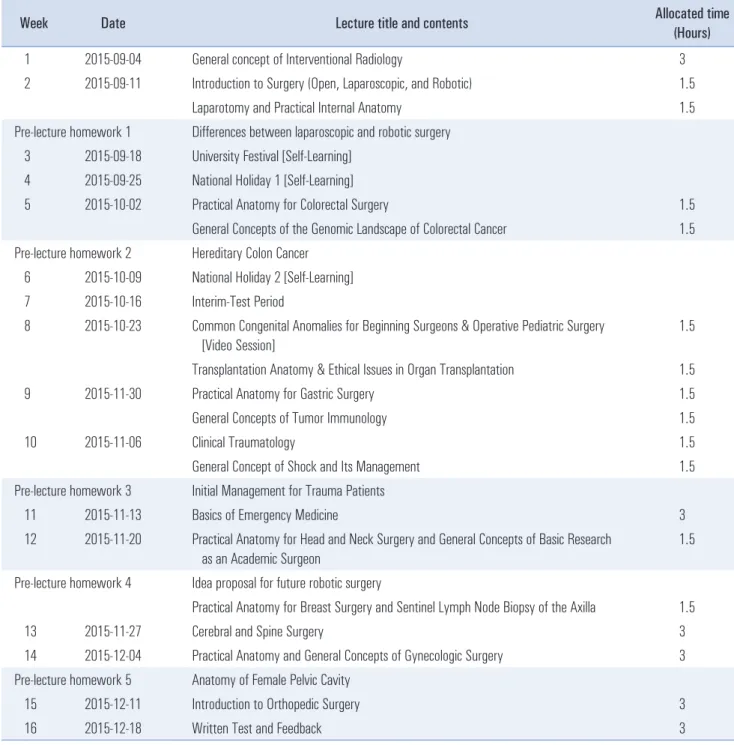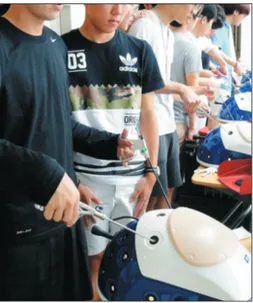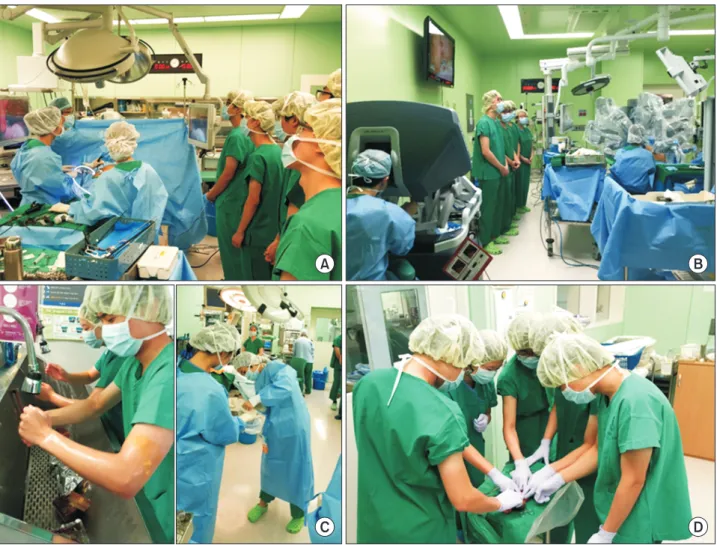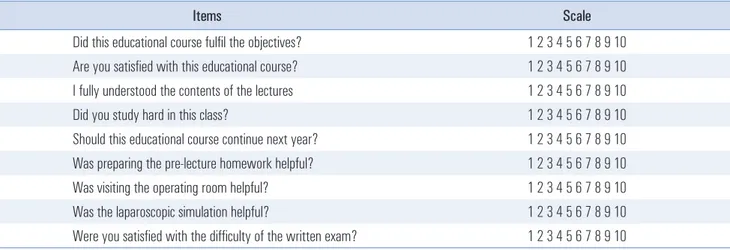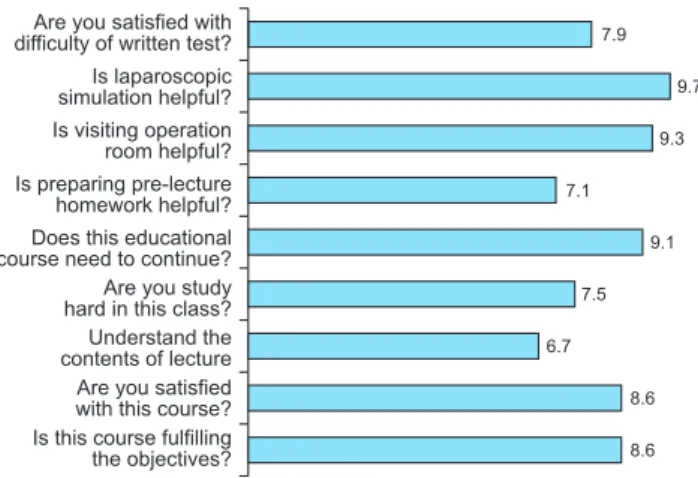What We Learned from the Experience of an Introduction to
Surgery Class for First Grade Premedical Students
Chang Moo Kang, M.D.,Ph.D.
Division of Hepatobiliary and Pancreatic Surgery, Department of Surgery, Yonsei University College of Medicine, Seoul, Korea
Purpose: In order to enhance the goal of premedical education, we developed new clinical educational course of surgery for first-grade premedical students.
Methods: In 2015, from September 4th to December 18th, the educational performance records of first-grade premedical students were evaluated, who attended the new, optional major class Introduction to surgery for future doctors. The non-compliance score was calculated as the sum of the total frequency of absences, number of late arrivals to class, and failure to submit the pre-lecture homework. This score was correlated with students’ educational performance records. The premedical students’ feed-back about this new class was summarized.
Results: Among 79 first-grade premedical students at Yonsei University College of Medicine, 43 premedical students (54.4%) chose to attend the new class. Premedical students’ individual non-compliance scores were inversely and significantly correlated to written test performance (R2=0.237, p=0.001). In survey analysis, the mean score for premedical students’ course satisfaction was 8.6. They strongly suggested this new educational course should be continued for first-grade premedical students with a mean rating of 9.1. Premedical students were very impressed and satisfied by laparoscopic surgical simulation and visiting the operating room, with ratings of 9.7 and 9.3, respectively.
Conclusion: This class is the first movement to introduce the surgery to the premedical students in Yonsei University. In spite of their scanty medical knowledge, this clinical class can provide positive influence on educational motivation as premedical students. Further modification of this class is mandatory based on what we learned from this educational experience.
Keywords: Surgery, Education, Motivation, Surgical simulation, Premedical student
Received September 26, 2016
Accepted February 8, 2017
Corresponding author
Chang Moo Kang
Division of Hepatobiliary and Pancreatic Surgery, Department of Surgery, Yonsei University College of Medicine, 50 Yonsei-ro, Seodaemun-gu, Seoul 03722, Korea Tel: +82-2-2228-2135
Fax: +82-2-313-8289 E-mail: cmkang@yuhs.ac
This is an Open Access article distributed under the terms of the Creative Commons Attribution Non-Commercial License (http:// creativecommons.org/licenses/by-nc/4.0/) which permits unrestricted non-commercial use, distribution, and reproduction in any medium, provided the original work is properly cited.
Copyright © 2017 The Journal of Minimally Invasive Surgery. All rights reserved.
Journal of Minimally Invasive Surgery
J Minim Invasive Surg 2017;20(1):34-41
INtROduCtION
In Korea, students who wish to become doctors must com-plete two years of premedical coursework followed by four years of medical courses. While the personal motivations to become doctors vary, it is believed that most students enter medical school to become doctors. It is also reasonable to be-lieve that when premedical students begin their coursework
they are excited and expect to anticipate learning basic medi-cal sciences and enhancing their knowledge of the human body. Indeed, premedical students may be eager to jump into the pathophysiology of human diseases as well as learn how to perform physical examinations, make skin incisions, suture for primary repair, and so forth.
However, contrary to these expectations, most first grade medical students must take a scheduled set of humanities,
sci-ence, biology, physics, mathematics, and language courses. First-grade premedical students have already been exposed to a similar ‘ready-scheduled’ educational environment dur-ing the latter parts of high school. Certainly, these scheduled classes are very important and provide an excellent opportu-nity for premedical students to better understand the ‘human-beings’ that they will treat as patients upon becoming doctors. On the other hand, we also need to admit that premedical students may feel that the two years of premedical courses are
boring, especially if their overall purpose is delivered in the context of “understanding humans”.
The huge gap between a premedical student’s self-educa-tional motivation “to become a doctor” and the educaself-educa-tional content during premedical studies may render that education unproductive.1-4
That is, if premedical courses do not cover basic concepts of the actual clinical practice of a doctor, pre-medical students may have difficulty in understanding why their attendance at these traditional lectures is necessary,
es-Table 1. Time-table of lectures for the clinical educational course Introduction to surgery for future doctors
Week Date Lecture title and contents Allocated time (Hours)
1 2015-09-04 General concept of Interventional Radiology 3
2 2015-09-11 Introduction to Surgery (Open, Laparoscopic, and Robotic) 1.5
Laparotomy and Practical Internal Anatomy 1.5
Pre-lecture homework 1 Differences between laparoscopic and robotic surgery 3 2015-09-18 University Festival [Self-Learning]
4 2015-09-25 National Holiday 1 [Self-Learning]
5 2015-10-02 Practical Anatomy for Colorectal Surgery 1.5
General Concepts of the Genomic Landscape of Colorectal Cancer 1.5 Pre-lecture homework 2 Hereditary Colon Cancer
6 2015-10-09 National Holiday 2 [Self-Learning] 7 2015-10-16 Interim-Test Period
8 2015-10-23 Common Congenital Anomalies for Beginning Surgeons & Operative Pediatric Surgery [Video Session]
1.5 Transplantation Anatomy & Ethical Issues in Organ Transplantation 1.5
9 2015-11-30 Practical Anatomy for Gastric Surgery 1.5
General Concepts of Tumor Immunology 1.5
10 2015-11-06 Clinical Traumatology 1.5
General Concept of Shock and Its Management 1.5
Pre-lecture homework 3 Initial Management for Trauma Patients
11 2015-11-13 Basics of Emergency Medicine 3
12 2015-11-20 Practical Anatomy for Head and Neck Surgery and General Concepts of Basic Research as an Academic Surgeon
1.5 Pre-lecture homework 4 Idea proposal for future robotic surgery
Practical Anatomy for Breast Surgery and Sentinel Lymph Node Biopsy of the Axilla 1.5
13 2015-11-27 Cerebral and Spine Surgery 3
14 2015-12-04 Practical Anatomy and General Concepts of Gynecologic Surgery 3 Pre-lecture homework 5 Anatomy of Female Pelvic Cavity
15 2015-12-11 Introduction to Orthopedic Surgery 3
pecially when the lectures are not directly related to their fu-ture medical specialty. Thus, maximizing the pure educational goal of understanding “human-beings” during the premedical period may be enhanced by introducing concepts of clinical practice early on. In order to lessen the gap between theoreti-cal purposes of premeditheoreti-cal courses and unmet needs of pre-medical students’expectations, starting in 2015 we introduced the course Introduction to surgery for future doctors for first grade premedical students at the Yonsei University College of Medicine.
Why teach surgery to premedical students? We constructed the following hypothesis at the time of planning the new introductory surgery class as part of the premedical educa-tional coursework. First, we took into account that surgery is a curious and interesting subject not only for premedical students, but also for the general population. Specifically, many people are interested in learning what happens in the operating theater, where typically only authorized persons are allowed to enter. We believed that this curiosity could play an important role as an educational motivation for premedi-cal students. Therefore, we considered that most premedipremedi-cal students, despite having very little medical knowledge, would be interested and motivated to understand the practical is-sues related to surgery as well as perform surgical procedures. Second, understanding underlying physiologic mechanisms of ‘medical disease’ may be very difficult for premedical students to follow. In contrast, there are many opportunities for visual feedback in the operative theater, where it is easy for pre-medical students to have both direct and indirect experience with clinical and practical aspects of being a surgeon. Ac-cordingly, we believed that the new introductory surgery class would afford premedical students an opportunity to establish indirect experiences that they could connect with in their fu-ture clinical practices. Furthermore, we thought that this new educational environment would provide premedical students with a chance to dream about their future identities as doctors, allowing them to better focus and put into context their cur-rent responsibilities as premedical students.
In the present study, we introduce our experience with the surgical education of first-grade premedical students. We also explored the educational meaning and future perspectives of this new clinical course as a part of the educational program for premedical students.
mAtERIAlS ANd mEthOdS
Study population
In 2015, from September 4th
to December 18th
, we evaluated the educational performance records of 43 first-grade
pre-medical students who attended the new, optional major class Introduction to surgery for future doctors.
Brief introduction of the clinical class
A class Introduction to surgery for future doctors was estab-lished for first-grade premedical students of Yonsei University College of Medicine. The objectives of this educational course were to provide a basic academic knowledge of surgery as well as to (1) provide students the chance to study the general con-cept of surgery, (2) encourage self-motivation by allowing stu-dents to dream about their careers as future doctors, (3) shed light on the importance of the premedical educational period as it pertains to students, and (4) prepare students for their fu-ture medical education.
In order to fulfill these goals, surgery and surgery-related basic and practical lectures were organized as part of the course (Table 1). In addition, the opportunity for premedical students to directly experience the principle of laparoscopic surgery (Fig. 1) and visit the operating room was provided to increase educational efficacy and student interest. All 43 pre-medical students (from 4 to 8 prepre-medical students a day) were scheduled to visit the operating room of Severance Hospital, Seoul, Korea, and to experience the current clinical practice of elective surgery performed at the Department of Surgery, Yonsei University College of Medicine (Fig. 2). Student evalu-ation was based on the following criteria (score proportion):
Fig. 1. Laparoscopic simulation for premedical students. In order to en-hance the understanding the lecture about laparoscopic surgery, the pre-medical students had chance to control the laparoscopic simulator before the lecture. Laparoscopic simulation was thought to be very excellent tool for the medical students to get interested in surgery.
attendance (30%), pre-lecture homework (20%), in-class ac-tivities (10%), and a written test (40%). All premedical students were asked to submit pre-lecture homework (comprising a report) through an online system prior to attending class (four times during the course period). Before the final written test, the important concepts discussed in each lecture were posted online to provide students a summary of what they learned during the course and to help them prepare for the written test.
Definition of variables
The term student compliance was created to evaluate how actively the premedical students were involved in the new class. Student non-compliance was estimated based on the frequency of absences, late arrivals to class, and whether stu-dents completed the pre-lecture homework. The non-compli-ance score was calculated as the sum of the total frequency of
absences, number of late arrivals to class, and failure to submit the pre-lecture homework during the course. For example, a non-compliance score of 3 (2+0+1) was assigned when a stu-dent was absent to the class twice (2), never late to class (0), and failed to submit the pre-lecture homework once (1) during the course. Non-compliance scores were compared with writ-ten test scores to estimate the impact of students’ attitudes on their educational performance in this new class.
Premedical student feedback analysis
Survey questions were provided to all 43 premedical stu-dents (Table 2). Survey answers were anonymous and collected for analysis. The scale ranged from 0 to 10 representing the most negative and most positive responses, respectively.
Fig. 2. Visiting operation room. The premedical students were scheduled to experience the clinical practice of surgery in operative theater. They ob-served the current practice of open, laparoscopic (A), and robotic surgery (B). They had chance for surgical scrub (C) and observing surgical specimen (D).
A B
Statistics
Categorical variables were expressed by frequency (%) and continuous variables were described as the mean±standard deviation. Chi-square and student-t test were applied in com-parative analysis. Linear regression model was performed to correlate between continuous variables. p values less than 0.05 were regarded as statistically significant.
RESultS
General characteristics of the students and
performance scores
Among 79 first-grade premedical students at Yonsei Uni-versity College of Medicine, 43 premedical students (54.4%) chose to attend the new class Introduction to surgery for future doctors as an optional course of specialty. Thirty-five students (81.4%) were male and 8 (18.6%) were female with an aver-age aver-age of 20.4±0.8 years. The mean score of the written test performance was 29.1±7.2 (reference score: 0~40). The total score according to written test scores and those evaluating the students’ compliance was 77.7±16.7 (reference score: 0~100). Written test performance score and total score were not sig-nificantly different according to age or gender (p>0.05).
General characteristics of student compliance
During the course, 18 students (41.0%) attended all classes and 33 students (76.7%) had less than two absences to the class. A total of 27 students (62.8%) consistently attended class in a timely manner, and 21 students (48.8%) completed all of the pre-lecture homework assignments. Table 3 shows a detailed summary of premedical student compliance scores. The mean
non-compliance score was 2.9±2.5.
Correlation between non-compliance and written test
performance
Premedical students’ individual non-compliance scores were inversely and significantly correlated to written test perfor-mance (R2=0.237, p=0.001, Fig. 3). In subgroup analysis, the
number of absences (R2=0.316, p<0.001) and failure to submit
Table 2. Student questionnaire for lecture feedback
Items Scale
Did this educational course fulfil the objectives? 1 2 3 4 5 6 7 8 9 10 Are you satisfied with this educational course? 1 2 3 4 5 6 7 8 9 10 I fully understood the contents of the lectures 1 2 3 4 5 6 7 8 9 10 Did you study hard in this class? 1 2 3 4 5 6 7 8 9 10 Should this educational course continue next year? 1 2 3 4 5 6 7 8 9 10 Was preparing the pre-lecture homework helpful? 1 2 3 4 5 6 7 8 9 10 Was visiting the operating room helpful? 1 2 3 4 5 6 7 8 9 10 Was the laparoscopic simulation helpful? 1 2 3 4 5 6 7 8 9 10 Were you satisfied with the difficulty of the written exam? 1 2 3 4 5 6 7 8 9 10
Table 3. Details of class compliance
Contents Frequency (%) Absent to class None 18 (41.0) Once 9 (20.9) Twice 6 (14.9) Three times 9 (20.9) Four times 1 (2.3) Late to class None 27 (62.8) Once 11 (25.6) Twice 5 (11.6) No pre-homework submission None 21 (48.8) Once 6 (14.0) Twice 4 (9.3) Three times 7 (16.3) Four times 5 (11.6)
pre-lecture homework (R2
=0.111, p=0.029) were found to have an inverse correlation with written test performance. In addi-tion, there was a positive relationship between the number of absences to the class and number of incomplete submissions of pre-lecture homework (p=0.001, Table 4). However,
late-ness to class was not associated with written test performance (R2
=0.003, p=0.474).
Determining a cut-off value for the non-compliance
score to identify candidates for active intervening
counseling
There was a significant relationship between written test performance and non-compliance score. As premedical stu-dents’ individual non-compliance scores increased, the p-val-ue of the difference with compliant students narrowed (Table 5). Especially, premedical students with non-compliance scores of greater than 4 showed no significant difference in written test performance compared to those with a score of less than 4. Therefore, it might be appropriate for the director of the class to intervene in a timely manner for students with high non-compliance scores (>4) in order to improve student outcomes.
Feedback analysis from 43 premedical students after
finishing the educational course
Among the 43 premedical students who attended this
W ritten test performance 40.00 30.00 20.00 10.00 0.00 Non-compliance score 0.00 R =0.237, =0.0012 p 10.00 8.00 6.00 4.00 2.00
Fig. 3. Correlation between non-compliance score and written test per-formance.
Table 4. Relationship between absences and incomplete submission of pre-lecture homework Incomplete
submission
Absence to the class
p value* 0 1 2 3 4 0 15 2 3 1 0 1 2 1 0 2 1 2 1 2 0 1 0 3 0 3 2 2 0 4 0 1 1 3 0 0.001
*Chi-square test, linear to linear association.
Table 5. Determining a cut-off value for a non-compliance score influencing written test performance
Non-compliance score Written test performance score p value
0 34.5±3.2 (n=9) vs. 27.7±7.3 (n=34) <0.001 1 33.6±2.9 (n=16) vs. 26.5±7.7 (n=27) <0.001 2 32.3±4.2 (n=23) vs. 25.5±8.2 (n=20) 0.002 3 31.8±4.2 (n=27) vs. 24.6±8.9 (n=16) 0.006 4 31.3±4.7 (n=31) vs. 23.6±9.4 (n=12) 0.019 5 29.7±7.5 (n=34) vs. 26.9±5.5 (n=9) 0.306 6 29.7±7.3 (n=38) vs. 24.6±2.8 (n=5) 0.138 7 29.1±7.3 (n=42) vs. 30.4 (n=1) 0.861
course, 42 students (97.7%) submitted the feedback response questionnaire. A summary of the responses is shown in Fig. 4.
Unlike our expectation and despite having only a premedi-cal student level of medipremedi-cal background knowledge prior to this new clinical class, students reported that they felt the educational course to introduce the general concept of sur-gery and related medical issues was successful in providing motivation toward future medical education. The mean scores for premedical students’ course satisfaction and whether the course goals were accomplished were both 8.6. In addition, the premedical students strongly suggested this new educational course should be continued for first-grade premedical students with a mean rating of 9.1.
Our survey results also revealed that there were some limi-tations in understanding of the lecture content by premedi-cal students, which had a mean score of 6.7. We attributed this score to fundamental shortage of background knowledge among premedical students, and make us modify the contents of the lecture to enhance educational effect. Nevertheless, premedical students were very impressed and satisfied by their experience with the laparoscopic surgical simulation and visit-ing the operatvisit-ing room, with ratvisit-ings of 9.7 and 9.3, respec-tively. Pre-lecture homework was also reported as somewhat helpful (mean score 7.9) with respect to its ability to help stu-dents understand the clinical lectures.
dISCuSSION
Based on our first experience with the introduction to sur-gery for premedical students, we believe that this clinical educational program could help premedical students gain mo-tivation for future medical education and learning. In addition, the indirect experience of clinical practice such as visiting the operative theater and surgical simulation may help students
consider how seriously they should take their premedical edu-cational courses.5,6
In order to safely establish this type of clinical class and provide the proper educational message for premedical stu-dents, it is important to adjust the level of the educational content of lectures. According to premedical students’ response to the difficulty of this class, many students reported hav-ing difficulty in fully understandhav-ing the professor’s lectures. However, despite this negative feedback, it was also interesting to note that many students were satisfied with this class, and were particularly very interested in the opportunity to experi-ence the practice of surgery, which included a visit to the op-erating room and laparoscopic surgical simulation. In addition, students expressed a positive attitude regarding whether this class should continue and if the class had fulfilled its objec-tives. Taken together, these findings suggest that the introduc-tion to surgery course was meaningful to the future doctors who participated.
It is not clear that written test performance (score) repre-sents the entire aspect of premedical students’ competence; however, it can be regarded as an objective parameter. Ac-cording to our results, written test performance was closely related to non-compliance score, calculated based on the number of absences, lateness to class, and failure to sub-mit pre-lecture homework. In addition, we identified a non-compliance score of 4 as an appropriate cut-off value to dif-ferentiate between students who scored significantly higher on the exam compared with those who did not. In other words, premedical students with non-compliance scores over 4 should receive a timely intervention to increase their competence, supported by the efforts of the course coordinator to motivate student achievement.7
This study was based on a very small number of premedical students from a single university. However, based on student feedback, the new clinical class during the premedical edu-cational period, Introduction to surgery for future doctors, played a role in helping premedical students prepare for a ca-reer in medicine and gain an appreciation of the importance of premedical education in this process.
Appropriate indirect exposure to clinical issues increases the efficacy of clinical education for premedical students.8,9
In our experience, written test performance is statistically associated with non-compliance scores, suggesting that proper timely intervention by the class director to decrease non-compliance score may modify student competence. Long-term student outcomes need to be evaluated to determine if our observa-tions and class will be effective in improving premedical education. To this end, we are planning a prospective cohort study aimed at correlating premedical student performance in this class with educational outcomes in their medical
educa-Fig. 4. Premedical students’ feedback about the present educational course. Just mean value was expressed at the top of the individual bar.
7.9 9.7 9.3 7.1 9.1 7.5 6.7 8.6
Are you satisfied with difficulty of written test? Is laparoscopic simulation helpful? Is visiting operation room helpful? Is preparing pre-lecture homework helpful? Does this educational course need to continue? Are you study hard in this class? Understand the contents of lecture Are you satisfied with this course? Is this course fulfilling
tion and competence as doctors at the end of medical school. A positive outcome of such studies will support the effective-ness of the type of clinical education described in this study to enhance the objectives of premedical education.
ACkNOwlEdgmENtS
The author, as the coordinator of the class Introduction to surgery for future doctors, would like to express sincere thanks to all of the faculty members involved for their devo-tion and contribudevo-tions to improve the quality of premedical student education: Man Deuk Kim1
, Byung Soh Min2
, Eun Young Chang2
, Dong Jin Joo2
, Jae Gil Lee2
, Hyun Soo Chung3
, Jandee Lee2
, Se Ho Park2
, Dong Kyu Chin4
, Sang Wun Kim5
, and Woo Jin Choi6
(in order of lectures). Particularly, the au-thor thanks Sunghee Bu7
who provided critical and valuable comments during developing context of this course (Depart-ment of Interventional Radiology1
, Surgery2 , Emergency Med-icine3 , Neurosurgery4 , Gynecology5 , Orthopedic Surgery6 , and Medical Education7
, Yonsei University College of Medicine, Seoul, Korea).
REFERENCES
1) Reeve J, Deci EL, Ryan RM. Self-determination theory : a dia-lectical framework for understanding sociocultural influences on student motivation. In: McInerney DM, Van Etten S, editors. Big theories revisited. Greenwich, Conn.: Information Age; 2004. 2) Kusurkar RA, Croiset G, Mann KV, Custers E, Ten Cate O. Have
motivation theories guided the development and reform of
medi-cal education curricula? A review of the literature. Acad Med 2012;87:735-743.
3) Vidic B, Weitlauf HM. Horizontal and vertical integration of academic disciplines in the medical school curriculum. Clin Anat 2002;15:233-235.
4) Dornan T, Littlewood S, Margolis SA, Scherpbier A, Spencer J, Ypinazar V. How can experience in clinical and community set-tings contribute to early medical education? A BEME systematic review. Med Teach 2006;28:3-18.
5) Bockers A, Lippold D, Fassnacht U, Schelzig H, Bockers TM. Ready for the OR? - Clinical anatomy and basic surgical skills for students in their preclinical education. GMS Z Med Ausbild 2011;28:Doc45.
6) Ali L, Nisar S, Ghassan A, Khan SA. Impact of clinical skill lab on students’ learning in preclinical years. J Ayub Med Coll Abbot-tabad 2011;23:114-117.
7) Al-Alwan I, Baig LA, Badri M, Magzoub ME, Alyousif S. Ef-fect of course coordinator behavior and motivation on students’ achievement: Results from five curriculum blocks of two under-graduate student cohorts at King Saud bin Abdulaziz University of Health Sciences. Pak J Med Sci 2015;31:457-461.
8) Waydhas C, Taeger G, Zettl R, Oberbeck R, Nast-Kolb D. Im-proved student preparation from implementing active learning sessions and a standardized curriculum in the surgical examination course. Med Teach 2004;26:621-624.
9) Wenrich M, Jackson MB, Scherpbier AJ, Wolfhagen IH, Ramsey PG, Goldstein EA. Ready or not? Expectations of faculty and medical students for clinical skills preparation for clerkships. Med Educ Online 2010;15.
